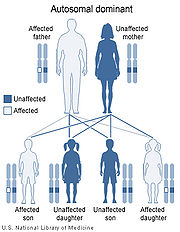
Hay-Wells syndrome
Encyclopedia
Hay–Wells syndrome is one of at least 150 known types of ectodermal dysplasia
.
These disorders affect tissues
that arise from the ectoderm
al germ layer
, such as skin, hair, and nails.
 Hay–Wells syndrome is autosomal dominant, caused by a missense mutation
Hay–Wells syndrome is autosomal dominant, caused by a missense mutation
in the Sterile alpha motif
(SAM) of the TP73L
(p63) gene
which encodes for a protein-protein interaction domain. It is a very rare disorder.
es are sparse or absent, nails may be absent or malformed, and teeth may be small and malformed. There may be fewer than normal sweat glands and they may produce little sweat, a condition known generally as hypohidrosis. Chronic inflammatory dermatitis of the scalp
is a common symptom.
Two features differentiate HWS from other ectodermal displasias. First, the syndrome is associated with cleft palate, and, less often, cleft lip. Second, the edges of the upper and lower eyelid
grow bands of fibrous tissue, often causing them to be fused together. This condition in the eyelids is called ankyloblepharon filiforme adnatum.
Ectodermal dysplasia
Ectodermal dysplasia is not a single disorder, but a group of syndromes all deriving from abnormalities of the ectodermal structures. More than 150 different syndromes have been identified. Despite some of the syndromes having different genetic causes the symptoms are sometimes very similar...
.
These disorders affect tissues
Tissue (biology)
Tissue is a cellular organizational level intermediate between cells and a complete organism. A tissue is an ensemble of cells, not necessarily identical, but from the same origin, that together carry out a specific function. These are called tissues because of their identical functioning...
that arise from the ectoderm
Ectoderm
The "ectoderm" is one of the three primary germ cell layers in the very early embryo. The other two layers are the mesoderm and endoderm , with the ectoderm as the most exterior layer...
al germ layer
Germ layer
A germ layer, occasionally referred to as a germinal epithelium, is a group of cells, formed during animal embryogenesis. Germ layers are particularly pronounced in the vertebrates; however, all animals more complex than sponges produce two or three primary tissue layers...
, such as skin, hair, and nails.
Genetics

Missense mutation
In genetics, a missense mutation is a point mutation in which a single nucleotide is changed, resulting in a codon that codes for a different amino acid . This can render the resulting protein nonfunctional...
in the Sterile alpha motif
Sterile alpha motif
Sterile alpha motif is a putative protein interaction module present in a wide variety of proteins involved in many biological processes. The SAM domain that spreads over around 70 residues is found in diverse eukaryotic organisms...
(SAM) of the TP73L
TP73L
Tumor protein p63 also known as transformation-related protein 63 is a protein that in humans is encoded by the TP63 gene.TP63 also known as the p63 gene was discovered 20 years after the discovery of the p53 tumor suppressor gene and along with p73 constitutes the p53 gene family based on their...
(p63) gene
Gene
A gene is a molecular unit of heredity of a living organism. It is a name given to some stretches of DNA and RNA that code for a type of protein or for an RNA chain that has a function in the organism. Living beings depend on genes, as they specify all proteins and functional RNA chains...
which encodes for a protein-protein interaction domain. It is a very rare disorder.
Diagnosis
In HWS the hair is coarse and sparse, eyelashEyelash
An eyelash or simply lash is one of the hairs that grow at the edge of the eyelid. Eyelashes protect the eye from debris and perform some of the same function as whiskers do on a cat or a mouse in the sense that they are sensitive to being touched, thus providing a warning that an object is near...
es are sparse or absent, nails may be absent or malformed, and teeth may be small and malformed. There may be fewer than normal sweat glands and they may produce little sweat, a condition known generally as hypohidrosis. Chronic inflammatory dermatitis of the scalp
Scalp
The scalp is the anatomical area bordered by the face anteriorly and the neck to the sides and posteriorly.-Layers:It is usually described as having five layers, which can conveniently be remembered as a mnemonic:...
is a common symptom.
Two features differentiate HWS from other ectodermal displasias. First, the syndrome is associated with cleft palate, and, less often, cleft lip. Second, the edges of the upper and lower eyelid
Eyelid
An eyelid is a thin fold of skin that covers and protects an eye. With the exception of the prepuce and the labia minora, it has the thinnest skin of the whole body. The levator palpebrae superioris muscle retracts the eyelid to "open" the eye. This can be either voluntarily or involuntarily...
grow bands of fibrous tissue, often causing them to be fused together. This condition in the eyelids is called ankyloblepharon filiforme adnatum.

